MARIANI’S
Virtual
Gourmet
November 18,
2018
NEWSLETTER
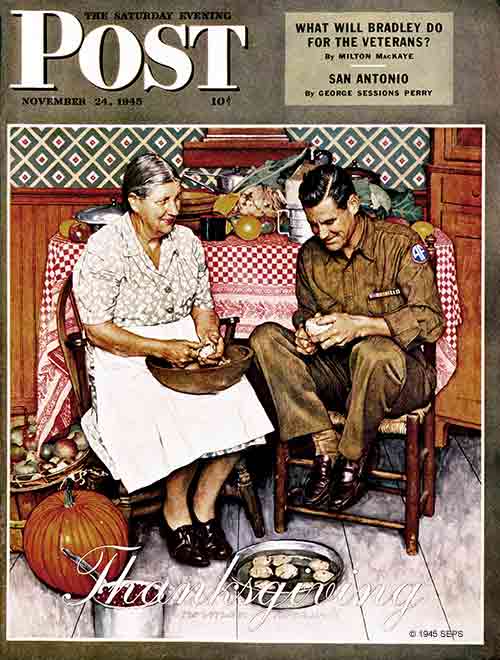
❖❖❖
IN THIS ISSUE
ABADIA RETUERTA
By John Mariani
NEW YORK CORNER
HORTUS
By John Mariani
NOTES FROM THE WINE CELLAR
THE WINES OF ABADIA RETUERTA
By John Mariani
❖❖❖
ABADIA RUERTA LEDOMAINE
By John Mariani
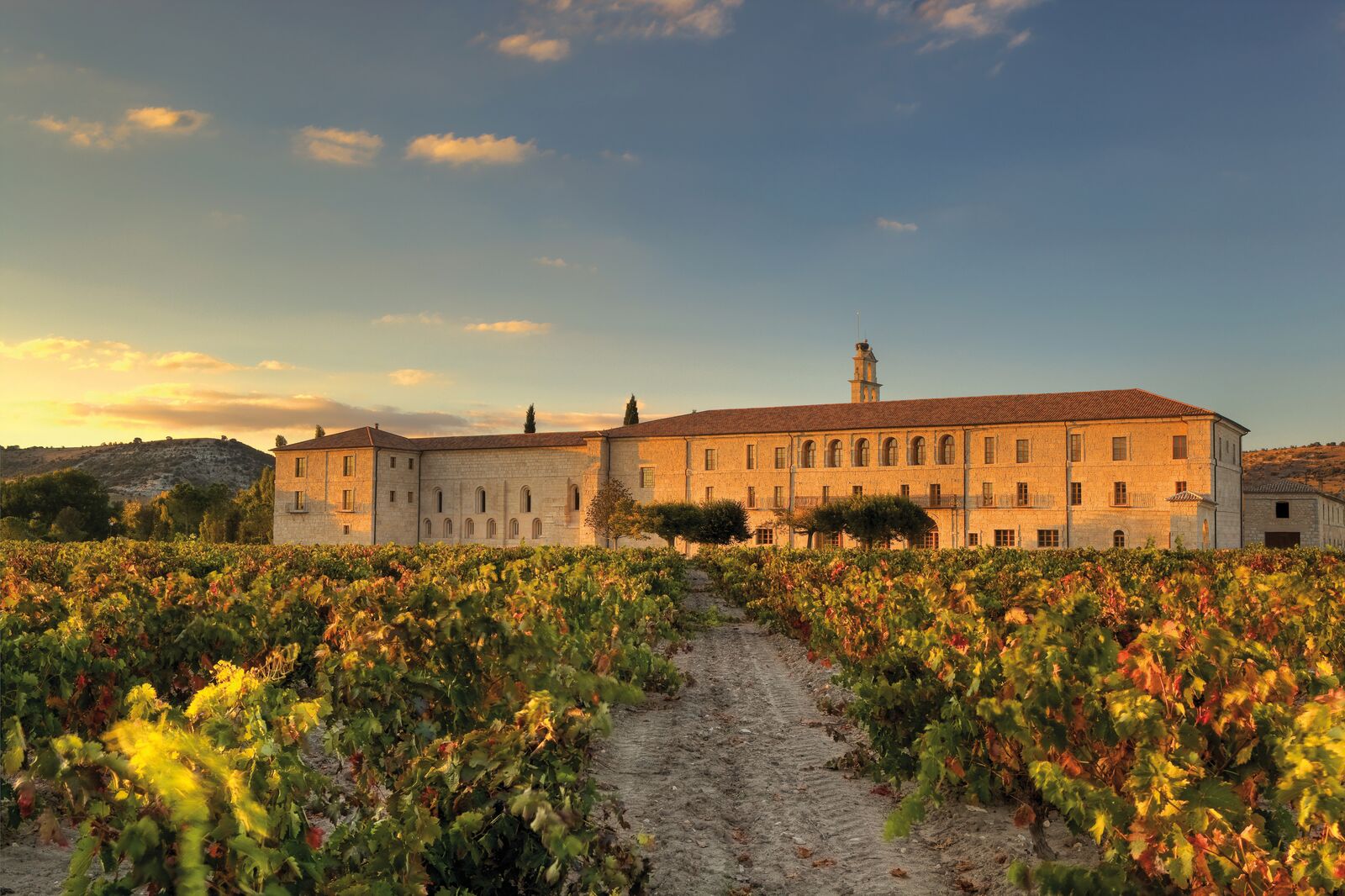
It might be enough to
restore an ascetic 12th century Romanesque abbey
two hours drive from Madrid into a 30-room,
five-star hotel with a Michelin-star restaurant,
but add to it a winery set on 1,730 wooded acres
in the heart of the Duero wine region and it
becomes evident why the cars parked at the
hotel’s entrance may well include a Maserati GT,
Porsche 911 Turbo S, and a top-of-the-line Land
Rover.
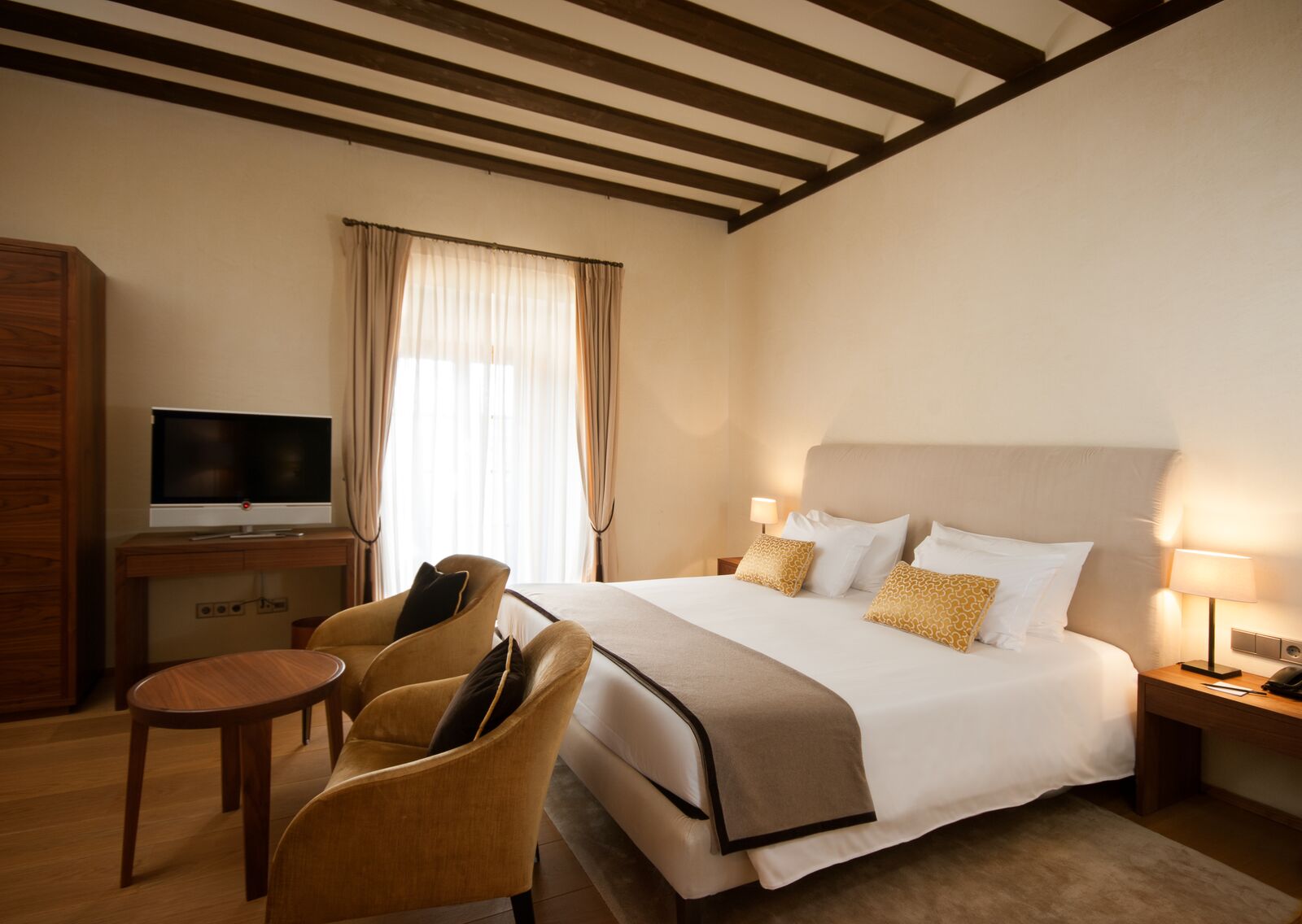 Abadía
Retuerta LeDomaine hotel, owned by Swiss multinational
pharmaceutical giant Novartis, opened in
2012 after a massive reclamation that won the EU’s
Europa Nostra Award for conserving the cultural
heritage of a decayed monastery. Today it would be
remarkable enough for the quiet beauty of the
buildings and landscape. What were once monks’ small,
somber cells have been expanded to 27 rooms and
three suites that include every amenity those
monks could never have dreamed of, including a
pillow menu, soundproof rooms with oak floors,
walnut furniture, well-stocked minibars,
luxuriously appointed bathrooms and 24-hour butler
service. The hallways are hung with 18th and 19th
century Spanish paintings and tapestries. This
past year about 50% of the guests have been
Spanish; 15% American.
Abadía
Retuerta LeDomaine hotel, owned by Swiss multinational
pharmaceutical giant Novartis, opened in
2012 after a massive reclamation that won the EU’s
Europa Nostra Award for conserving the cultural
heritage of a decayed monastery. Today it would be
remarkable enough for the quiet beauty of the
buildings and landscape. What were once monks’ small,
somber cells have been expanded to 27 rooms and
three suites that include every amenity those
monks could never have dreamed of, including a
pillow menu, soundproof rooms with oak floors,
walnut furniture, well-stocked minibars,
luxuriously appointed bathrooms and 24-hour butler
service. The hallways are hung with 18th and 19th
century Spanish paintings and tapestries. This
past year about 50% of the guests have been
Spanish; 15% American.
The
10,000-square-foot
Sanctuario LeDomaine Wellness & Spa (below), set
within a former stable, offers a biotherapy
program of holistic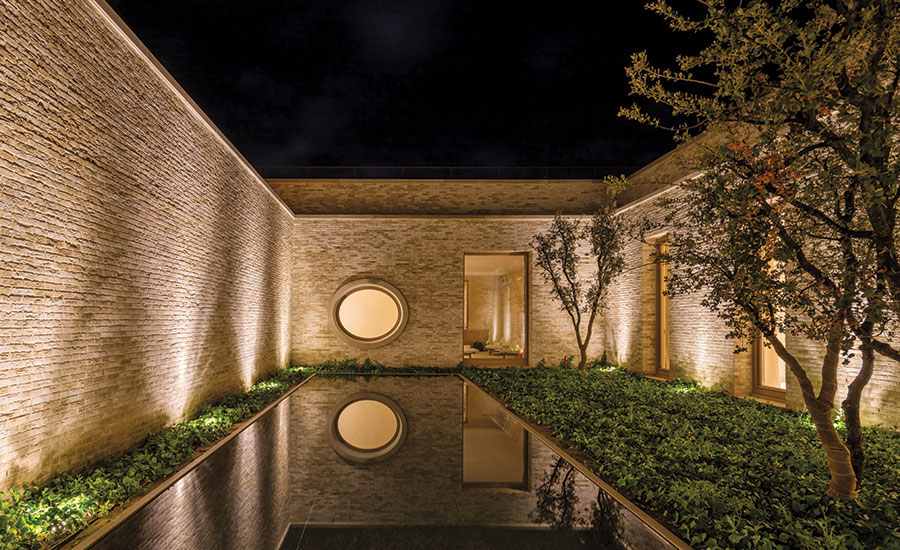 healing
and wellness reflecting the abbey’s location
within a surrounding vineyard and using
decalcified well water stored for use in the
facilities. It’s a good place to Zen out.
healing
and wellness reflecting the abbey’s location
within a surrounding vineyard and using
decalcified well water stored for use in the
facilities. It’s a good place to Zen out.
My wife
and I visited the hotel in September as the
harvest was ending, and guests are invited to tour
the vineyards with a guide, on a mountain bike, a
horse, even a helicopter. One of
our favorite moments was to enjoy a warm,
breeze-blown picnic (below) under an ancient oak
tree, eating cheese, bread and sausages and
drinking the vineyard’s wines. We declined an
opportunity to crush new grapes with our feet,
which is merely a frivolity at the
state-of-the-art winery. There is also an enclosed
sculpture garden of carved rocks within green
hedges.
The irony of Abadia’s winery is
that, while located on what is called “the Golden
Mile” of the Ribera del Duero region, it has never
been permitted an
official Ribera del Duero appellation because
its 500 acres lie just outside the official
zone—despite its vineyard being adjacent to
those of the
illustrious Vega Sicilia. (I write more
about the wines in another article this week.)
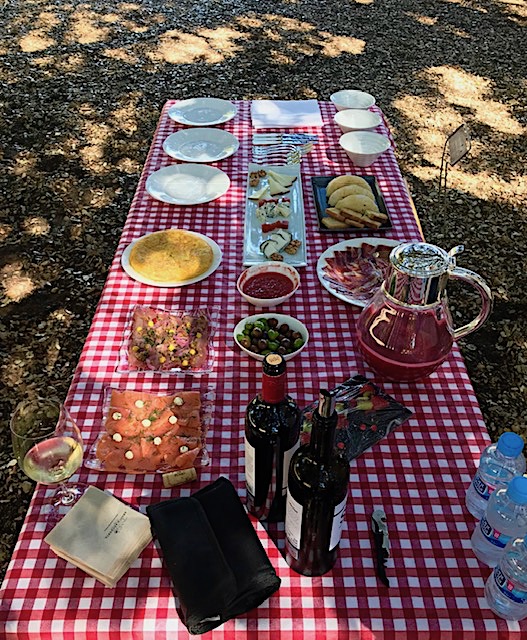 We had a chance to dine
at both of the property’s restaurants. The more
casual Vinoteca
(right),
which is located above the wine vault and whose
walls are lined with wine bottles, serves a
lighter, highly seasonal fare, with innovative
takes on tapas, like Ibérico pastrami with piparra
We had a chance to dine
at both of the property’s restaurants. The more
casual Vinoteca
(right),
which is located above the wine vault and whose
walls are lined with wine bottles, serves a
lighter, highly seasonal fare, with innovative
takes on tapas, like Ibérico pastrami with piparra 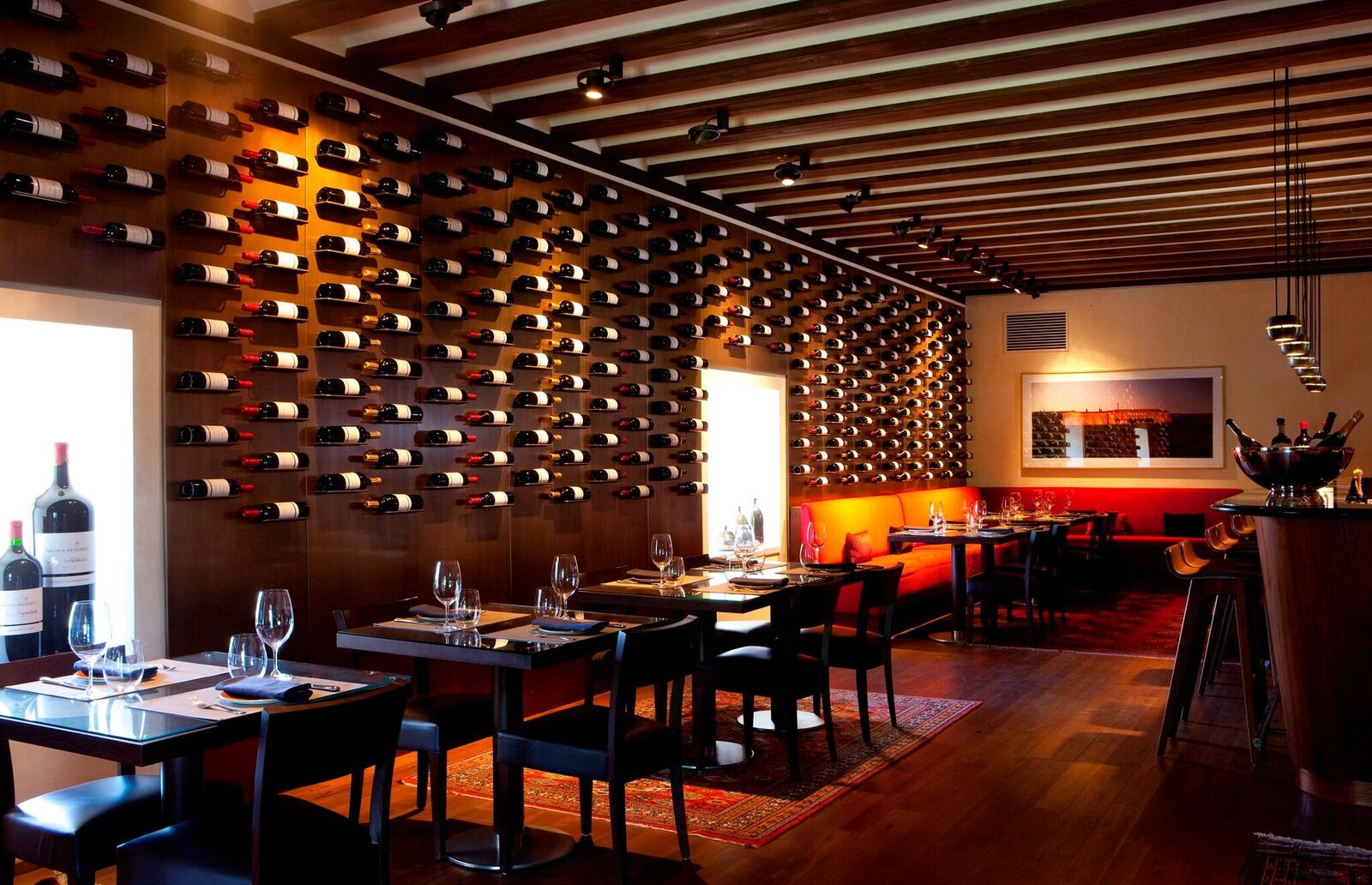 pepper, mushrooms
and hazelnuts (€22); a beet soup with sardines and
hazelnuts (€18); sweet and sour ratatouille with
chicken wings and poached quail eggs (€18); and
foie gras with red fruit in spiced wine (€22).
Main courses include baby lamb stew with a
mushroom duxelle (€26) and cod baked in cellophane
(€30). For dessert there’s a basil-scented custard
with biscuit and apple (€10).
pepper, mushrooms
and hazelnuts (€22); a beet soup with sardines and
hazelnuts (€18); sweet and sour ratatouille with
chicken wings and poached quail eggs (€18); and
foie gras with red fruit in spiced wine (€22).
Main courses include baby lamb stew with a
mushroom duxelle (€26) and cod baked in cellophane
(€30). For dessert there’s a basil-scented custard
with biscuit and apple (€10).
The Refectorio (below), with
its vaulted Gothic ceiling and restored fresco of
The Last Supper, where
the monks once ate their meager meals in silence,
is now a softly lighted dining room with a young
Spanish chef, Marc Segarra, who won his first
Michelin star serving tasting menus using Iberian
ingredients done with personal flair, color and a
respect for culinary traditions.
There are two fixed-price
menus: seven courses for €140, with wines an
added €75, and eleven courses for €160 + €75 for
wines (VAT and service included). 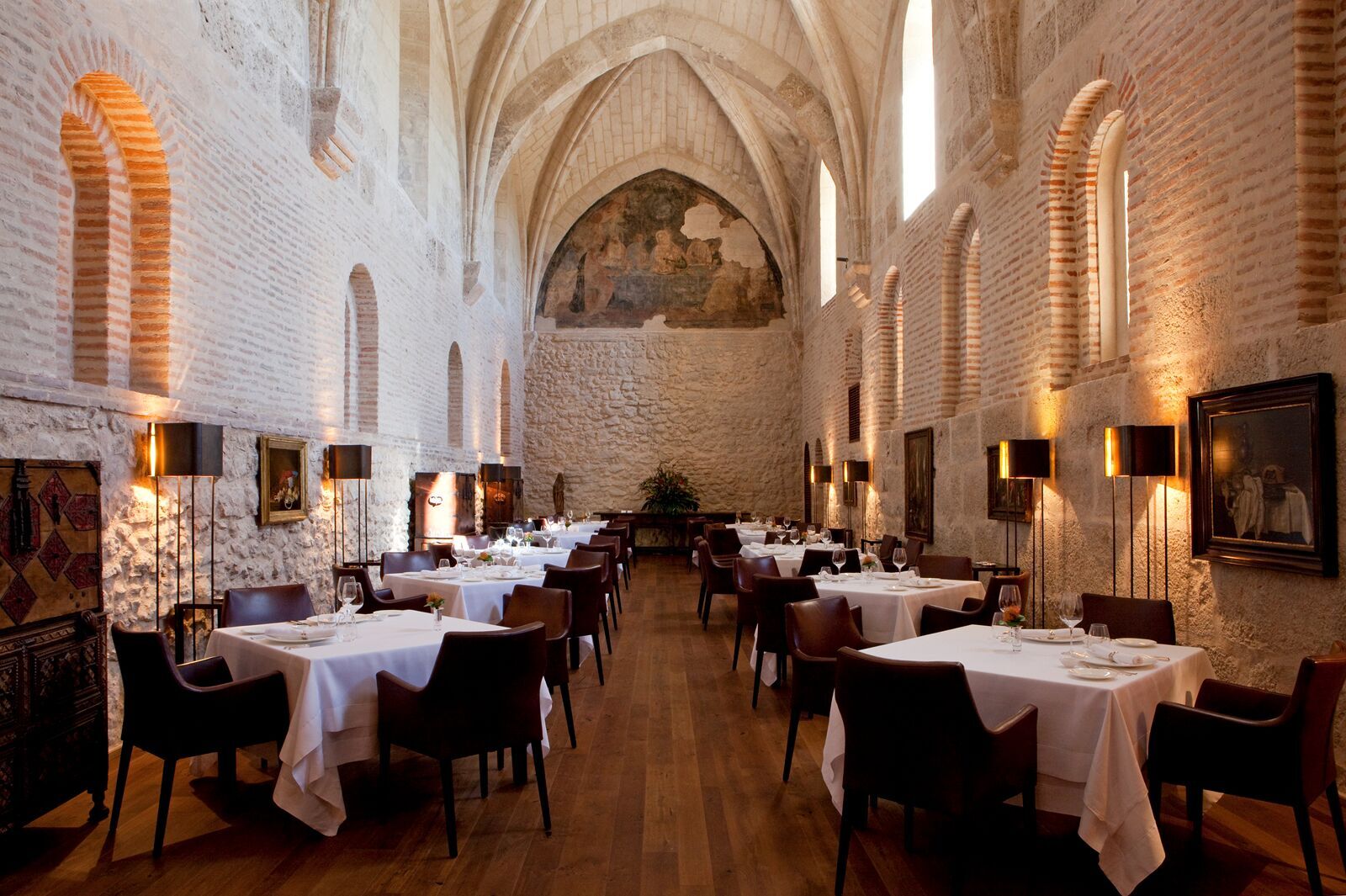 We chose the latter
and were amazed at the range of Segarra’s
cuisine, from small plates of garlic soup,
rice-filled blood sausage, and a beet cone with
steak tartare to courses that showed a strong
vegetable interest, like autumn’s mushrooms with
pine bud bread, then a main course of luscious
sea bream with a sauce made from its own bones,
and a gloriously composed suckling pig with
pumpkin and cardomon. Then came local cheeses,
lavish desserts and chocolates.
We chose the latter
and were amazed at the range of Segarra’s
cuisine, from small plates of garlic soup,
rice-filled blood sausage, and a beet cone with
steak tartare to courses that showed a strong
vegetable interest, like autumn’s mushrooms with
pine bud bread, then a main course of luscious
sea bream with a sauce made from its own bones,
and a gloriously composed suckling pig with
pumpkin and cardomon. Then came local cheeses,
lavish desserts and chocolates.
After
leaving the horn-blaring intensity of Madrid, I
felt the urban stress drop away as we reached the
untouched land around Abadia Retuerta. Indeed, the
monastery-like quiet of LeDomaine is one of its
most endearing virtues. Only in the lobby, lounge
and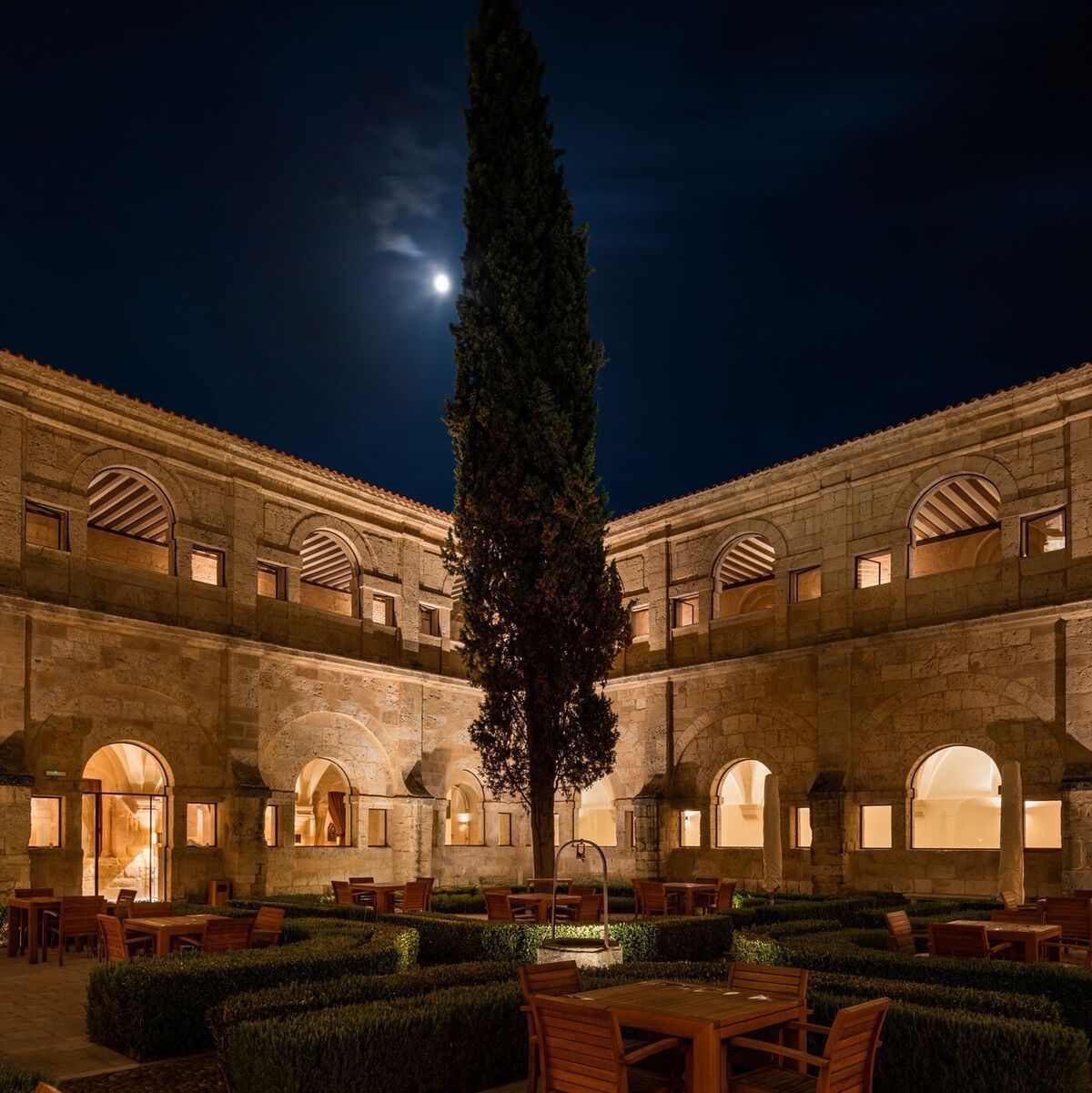 dining areas do you
hear conversations. You might sit alone in the
garden or among the pillared cloisters or in the
vaulted chapel where the sunlight beams through
arched windows into a contemplative, holy space
lit only with candles. We had a full moon
that night, set against a dark starry sky
uncompromised by light pollution. The air
smelled of pine and the vineyards, their grapes
picked and crushed, seemed fast asleep.
dining areas do you
hear conversations. You might sit alone in the
garden or among the pillared cloisters or in the
vaulted chapel where the sunlight beams through
arched windows into a contemplative, holy space
lit only with candles. We had a full moon
that night, set against a dark starry sky
uncompromised by light pollution. The air
smelled of pine and the vineyards, their grapes
picked and crushed, seemed fast asleep.
❖❖❖
By John Mariani
646-858-3784
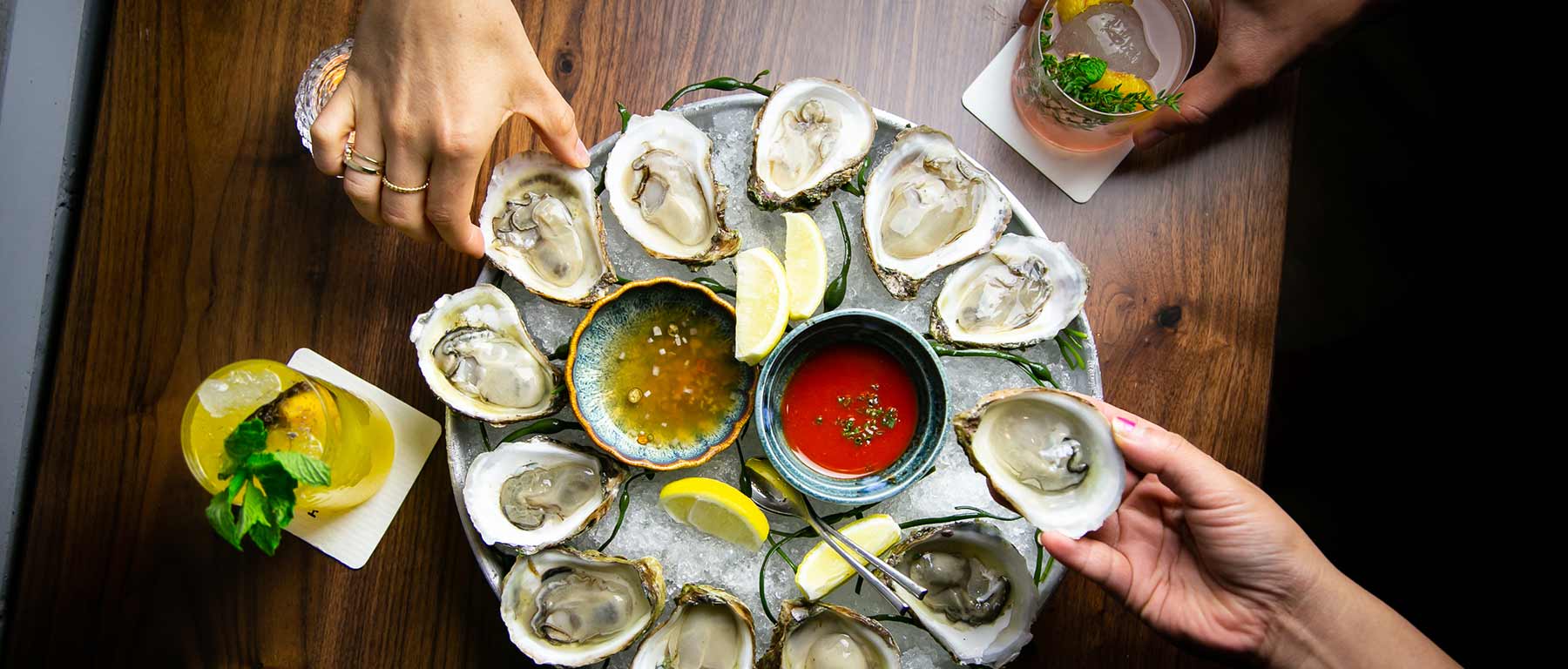
About twenty years
ago, when the term “Asian fusion” began
showing up on restaurant manifests, it all
seemed a little too pat: Take a chicken,
give it a dash of Asian spices, roast it and
serve it with mashed potatoes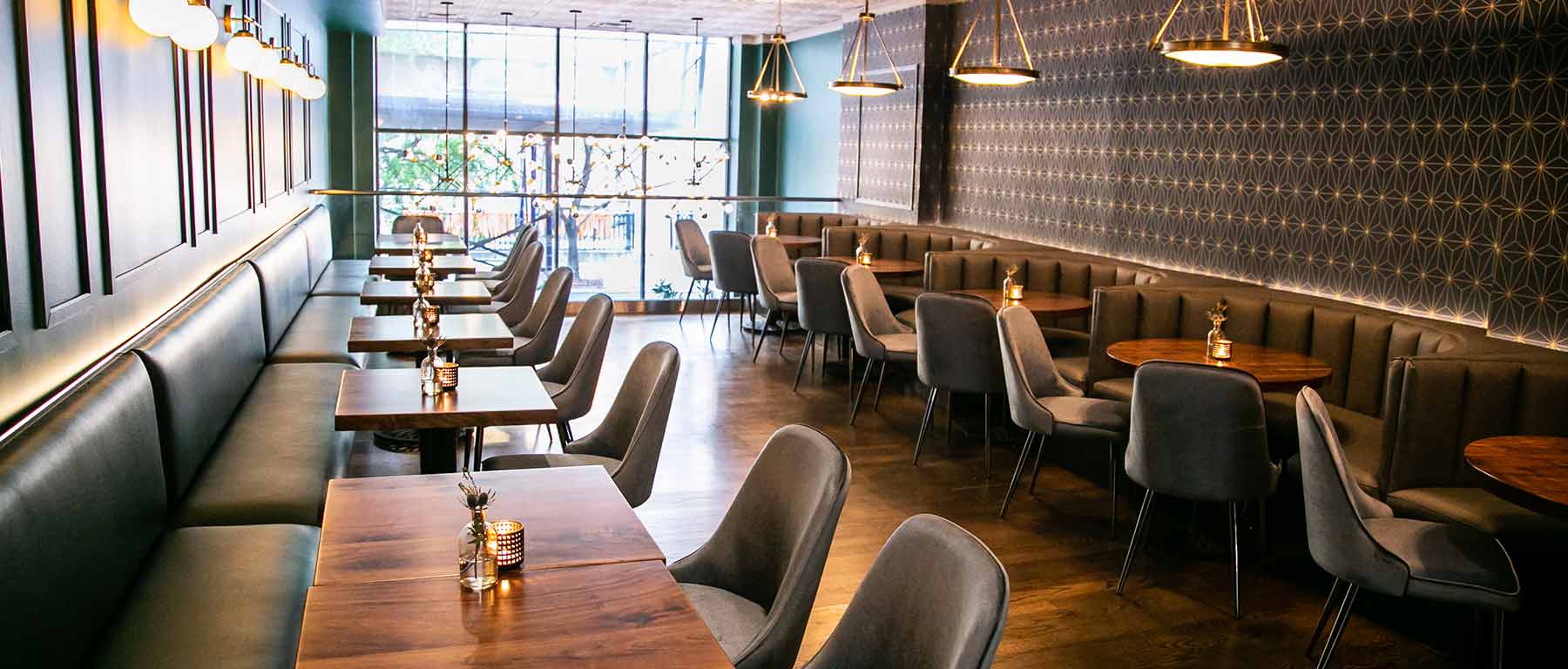 and
mango on the side. The trouble was that
outside of a two-week tour of Vietnam and
Cambodia, the American chefs had very little
experience working with Asian ingredients
and techniques and few options for obtaining
the kind of indigenous ingredients actually
used in those countries.
and
mango on the side. The trouble was that
outside of a two-week tour of Vietnam and
Cambodia, the American chefs had very little
experience working with Asian ingredients
and techniques and few options for obtaining
the kind of indigenous ingredients actually
used in those countries.
Nevertheless, from New York
to London to Paris, elements of Asian
cuisine—especially Japanese—became part of the
western way of cooking, so that today it’s
difficult not
to find some form of sushi, kefir lime,
kimchee and Sriracha on American menus. Sakes
are now more numerous than cognacs. In effect,
evolution has turned “Asian fusion” into a far
more harmonious style than it was when the
availability of good ingredients was next to
zero.
Hortus NYC is a very good
case in point. Open just three months now,
close to Madison Square Garden and the Garment
District, 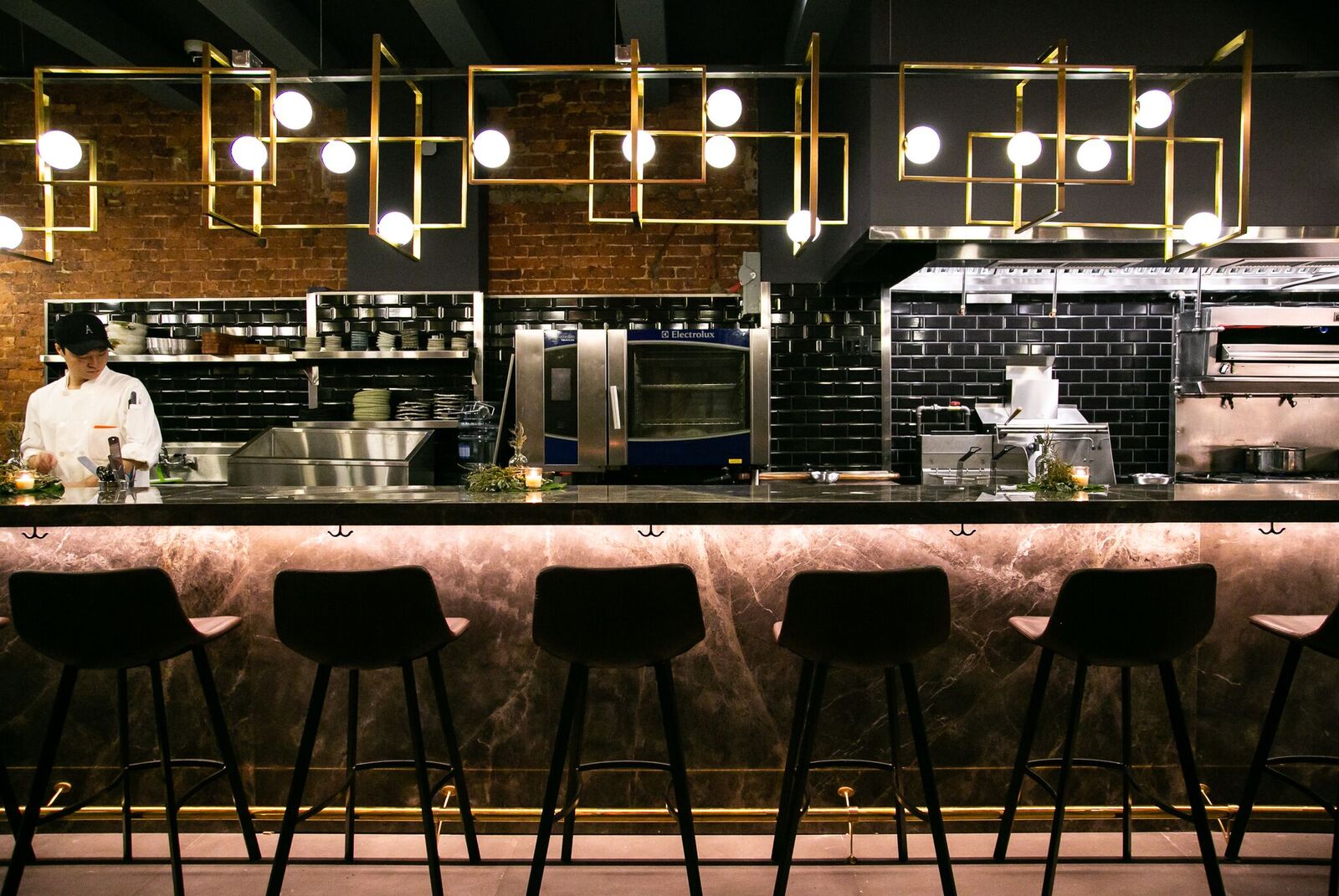 it is set on two
floors, the first centered around an open
kitchen with a pink marble counter and a
Chef’s Table; the second is the main dining
room, a handsome, well-lighted space arranged
with cushy deep green leather banquettes,
sconces hung on wood-framed deep green walls
and bare wooden tables with candles on them. A
wall of glass lets in the city’s lights. In
spring a garden area will open.
it is set on two
floors, the first centered around an open
kitchen with a pink marble counter and a
Chef’s Table; the second is the main dining
room, a handsome, well-lighted space arranged
with cushy deep green leather banquettes,
sconces hung on wood-framed deep green walls
and bare wooden tables with candles on them. A
wall of glass lets in the city’s lights. In
spring a garden area will open.
Partner and general manager
Suhum Jang (formerly at Per Se, Daniel and
Jung Sik) is a fine host and you sense that
he’s really intent on wanting to please you,
as much with the overall tenor of the
restaurant as with the imaginative,
beautifully presented cuisine of Chef
Seungjoon Choi, formerly of Blanca, Marea,
Lowlife and Gammeok. The Eastern-Western
crossover is clear on the menu, but I can’t
quite figure why there’s a whole section of
cheeses and charcuterie, which, while varied,
seems out of place. The wine list is adequate
for the cuisine, and there’s a list of
specialty cocktails ($11-$13), Japanese beers
and 14 sakes. Plates are of rustic ceramics
fitted to the colors of the dishes.
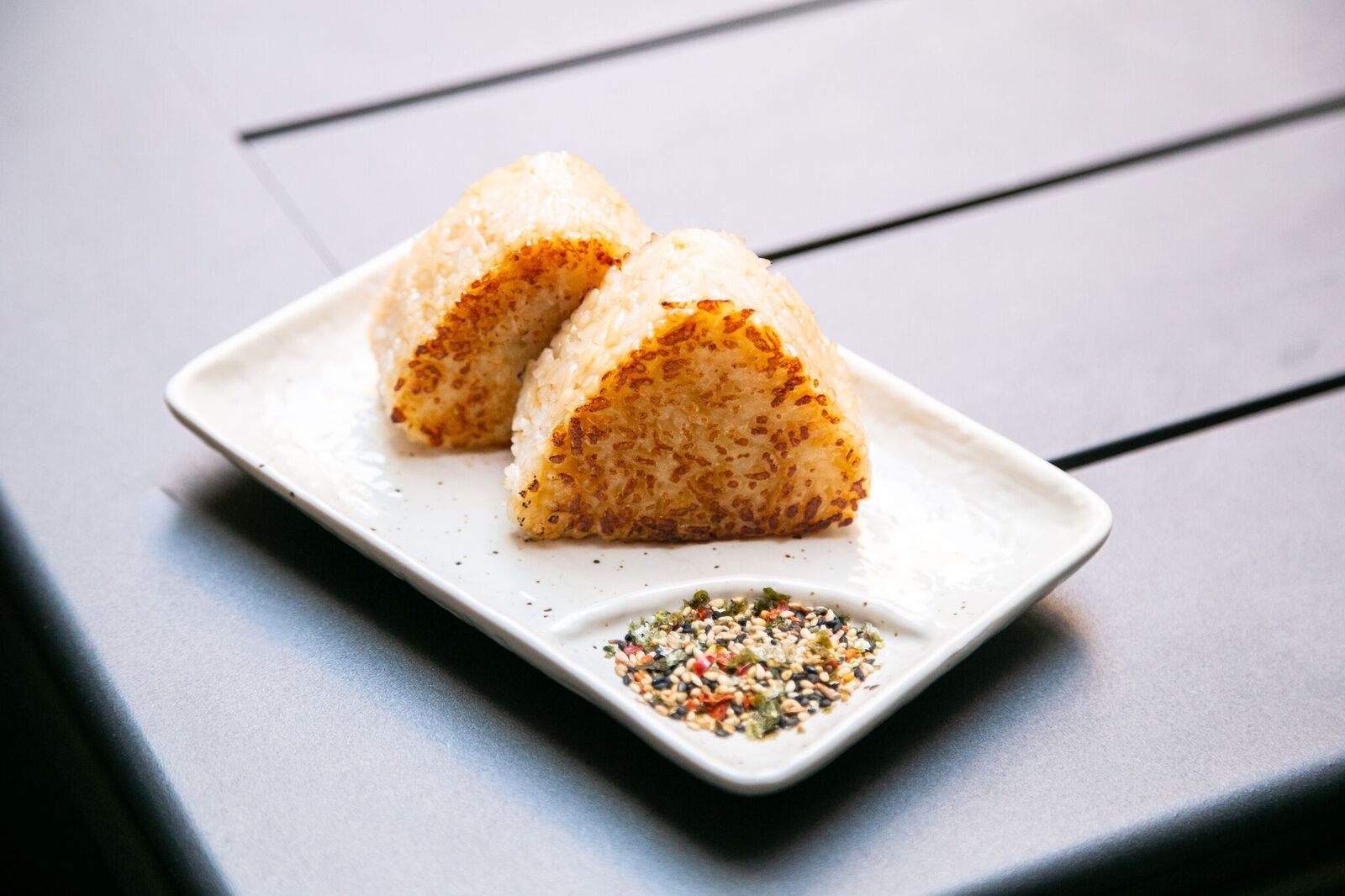 You
might want to begin with “raw” dishes, which
is a combination of traditional raw shellfish
American style that includes a remarkably good
King crab ($8), a species that generally lacks
luster and tastes watery, but here the
addition of crème fraiche, an Asian pear and
red sorrel makes it a novelty in the best
sense. A scallop ceviche gained interest from
orange, Calabrian chili and cilantro ($), but
jalapeño, cucumber and avocado did nothing to
enhance shrimp cocktail ($8). Sea urchin comes
on rice paper with lardo. ($13; below).
You
might want to begin with “raw” dishes, which
is a combination of traditional raw shellfish
American style that includes a remarkably good
King crab ($8), a species that generally lacks
luster and tastes watery, but here the
addition of crème fraiche, an Asian pear and
red sorrel makes it a novelty in the best
sense. A scallop ceviche gained interest from
orange, Calabrian chili and cilantro ($), but
jalapeño, cucumber and avocado did nothing to
enhance shrimp cocktail ($8). Sea urchin comes
on rice paper with lardo. ($13; below).
There is
another appetizer section, and here’s where
things get exciting, from a perfectly crisp
calamari tempura, whose center remained
creamy, with Korean shiso and a spicy mayo
($14) to Ssamjang hummus of roasted chickpeas
and seasonal vegetables ($12). Wonderfully
and subtly smoky was grilled eggplant with
minced pork, mozzarella, pine nuts and
breadcrumbs ($15)—a dish 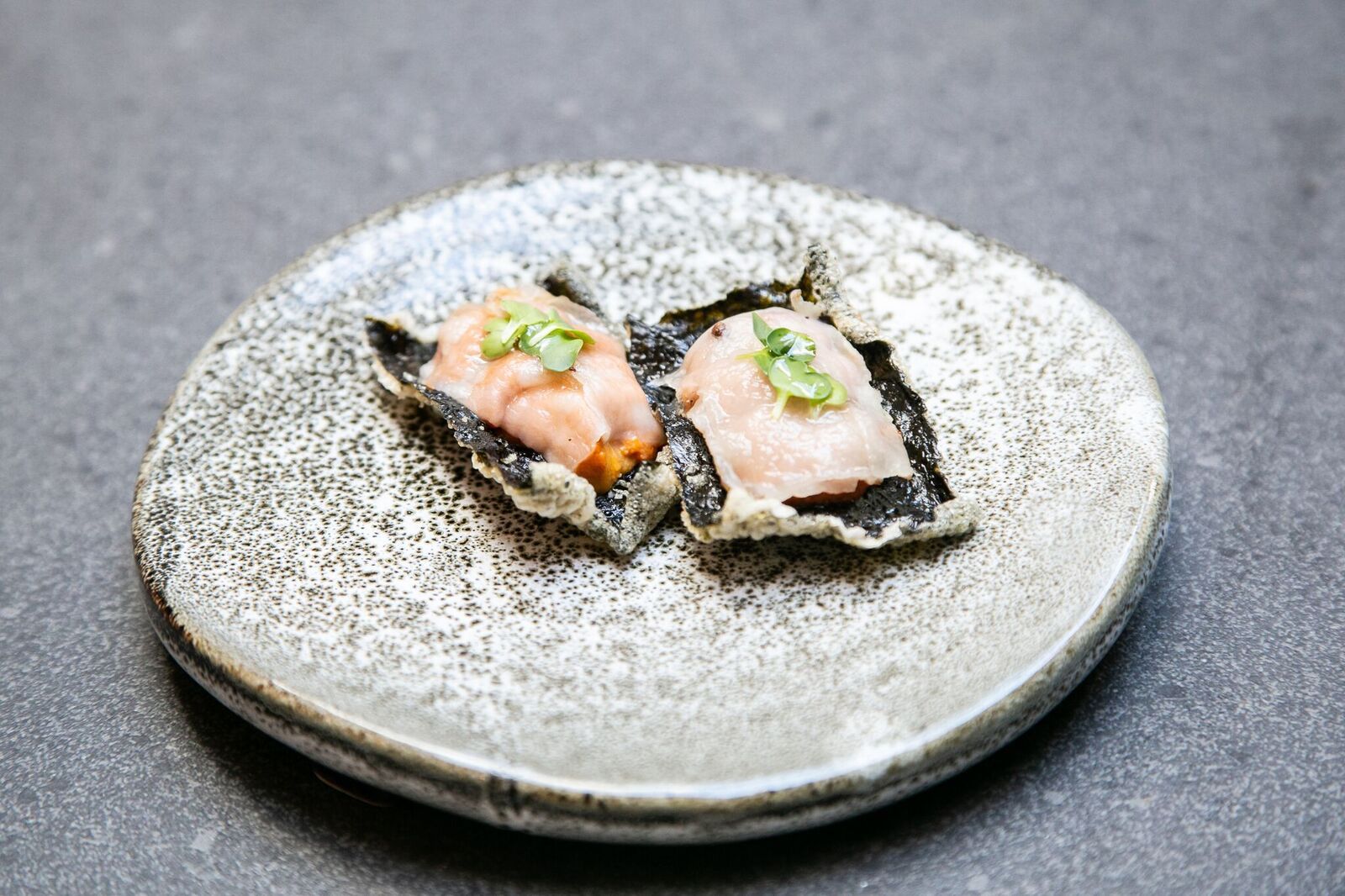 that
seemed to sum up the best that Chef Choi is
striving for, as does his simply named but
complex mushroom stew chock full of
Oregon matsutakes,
golden enoki,
shemeji and king trumpets with puffed
rice and tender bamboo shoots ($17).
that
seemed to sum up the best that Chef Choi is
striving for, as does his simply named but
complex mushroom stew chock full of
Oregon matsutakes,
golden enoki,
shemeji and king trumpets with puffed
rice and tender bamboo shoots ($17).
“To share” items are
generous, like the braised pork belly with
shiitakes and bok choy ($30) and a superb
grilled ribeye of beef with romaine, mushrooms
and galbi sauce ($42) that made me think of
Benihana without the pyrotechnics and
juggling. A big bowl of steamed cod, scallops,
mussels and shrimp in fragrant Thai basil and
bright kaffir lime ($25) had levels of deep
flavors that just kept revealing themselves
spoonful by spoonful.
Desserts
so rarely succeed in living up to what
precedes them in Asian restaurants, but
Hortus’s mango rice pudding made with
condensed milk and black lime ($7) is rich and
delicious, while Thai tea crème brûlée with
berries ($6) was pleasing if nothing more.
Open
Tues.-Sun. for dinner.
By John Mariani
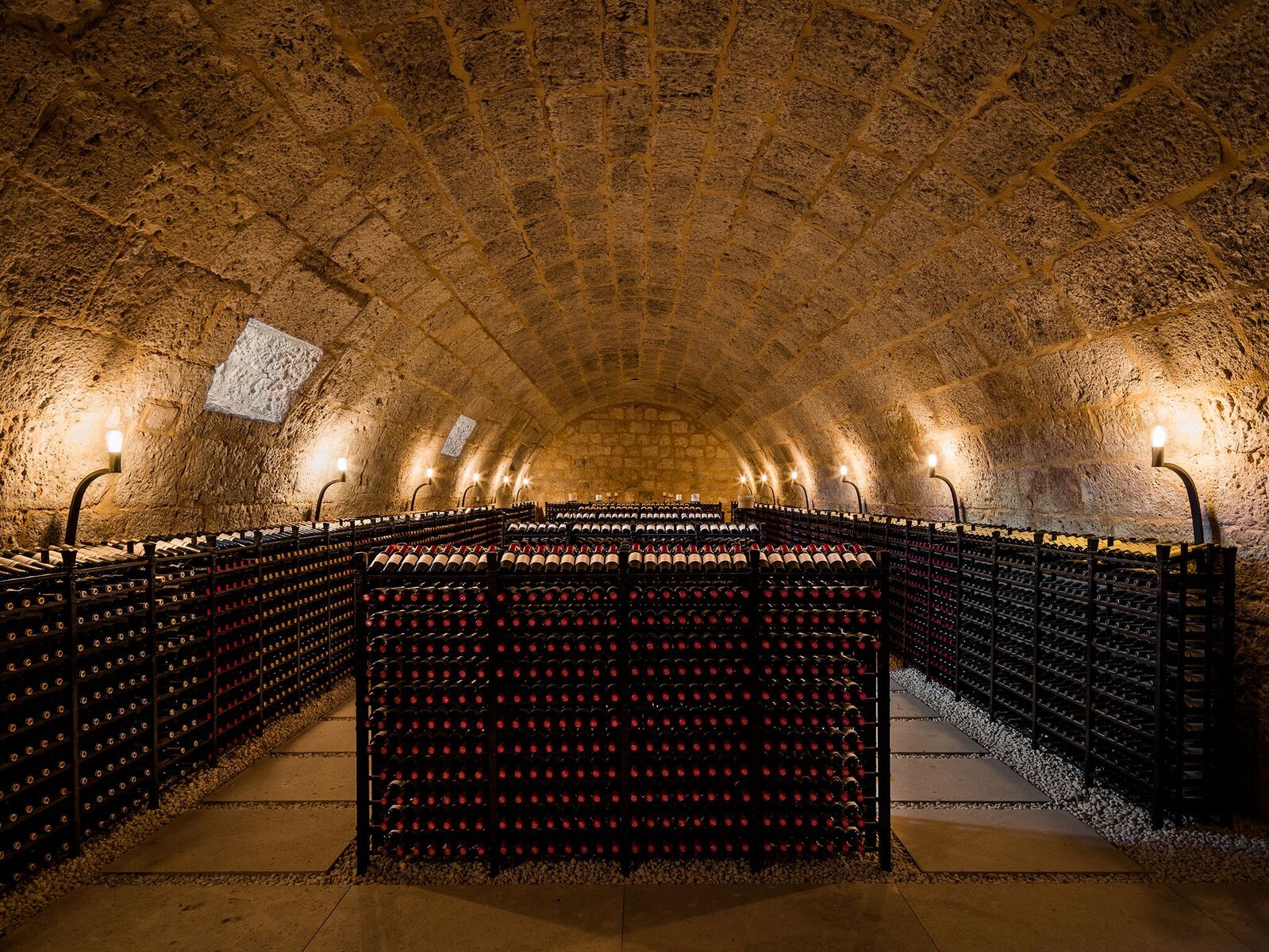
The wines of Abadia Ruerta in
Spain’s Rioja region have received justifiable
praise from the wine media, but Spain’s
Instituto Nacional de Denominaciones de Origin
still won’t grant the winery, established in
1996, an official appellation as Ribera del
Duero, this despite the fact that the Duero
River runs for almost three miles straight
through the winery’s 1,700-acre estate located
in the so-called “Golden Mile.”
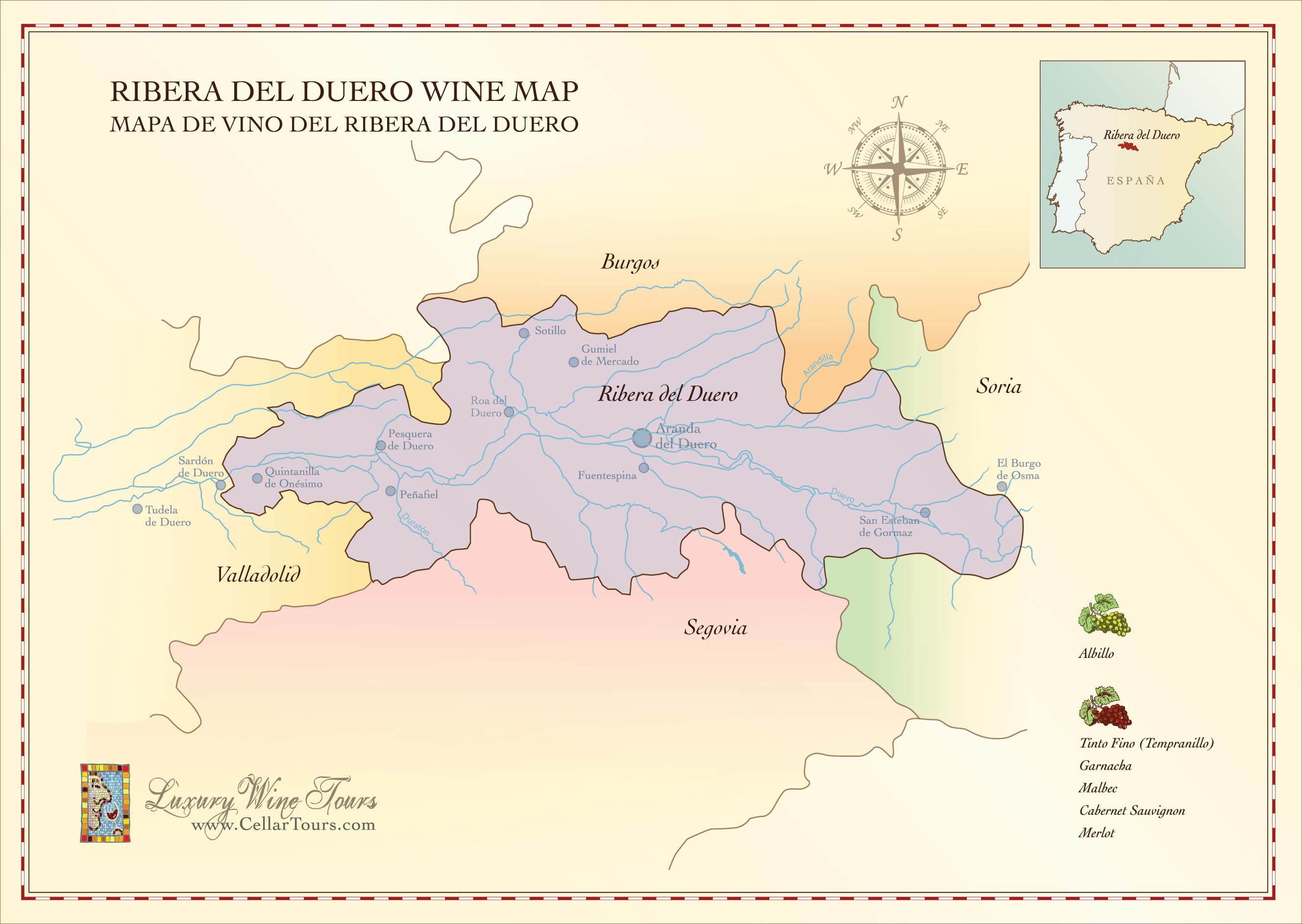 It wasn’t
until Spain entered the EU in 1986 that the
country’s Instituto actually classified vineyards
into 17 autonomous appellations, which included
Ribera del Douro.
It wasn’t
until Spain entered the EU in 1986 that the
country’s Instituto actually classified vineyards
into 17 autonomous appellations, which included
Ribera del Douro.
“It
was
a little bit frustrating at the very beginning,
because we did not have an appellation to
facilitate our international distribution," says
General Manager Enrique Valero (below). "Vega
Sicilia is five miles away from us and belongs to
the Ribera del Duero appellation, yet we are
labeled only Vino de la Tierra [wine of the land].
But we have developed our own Pagos [single
vineyard] wines and are very proud of the
personality they have and the international
recognition. In 2005 our Selección Especial 2001
won the International Wine Challenge in London as
the world’s best red wine. Time has demonstrated
we were right."
Valero
brought in consulting enologist Pascal Delbeck,
proprietor of the illustrious Premier Grand Cru
Bordeaux Château Ausone, while Ángel Anocíbar is the
on-premises winemaker. The vineyards are
planted with Tempranillo, Cabernet Sauvignon,
Merlot, Syrah and Petit Verdot, and the wines are
aged in combinations of stainless steel, French
and American oak. The
winery uses a state-of-the-art gravity
flow irrigation system. In fact, enormous
resources have been put into action to fight
global climate change, installing anti-frost
towers, studying biological cycles on vines grown
on dry-crop land, and establishing an Eco-workshop
to teach children about enoculture in the region.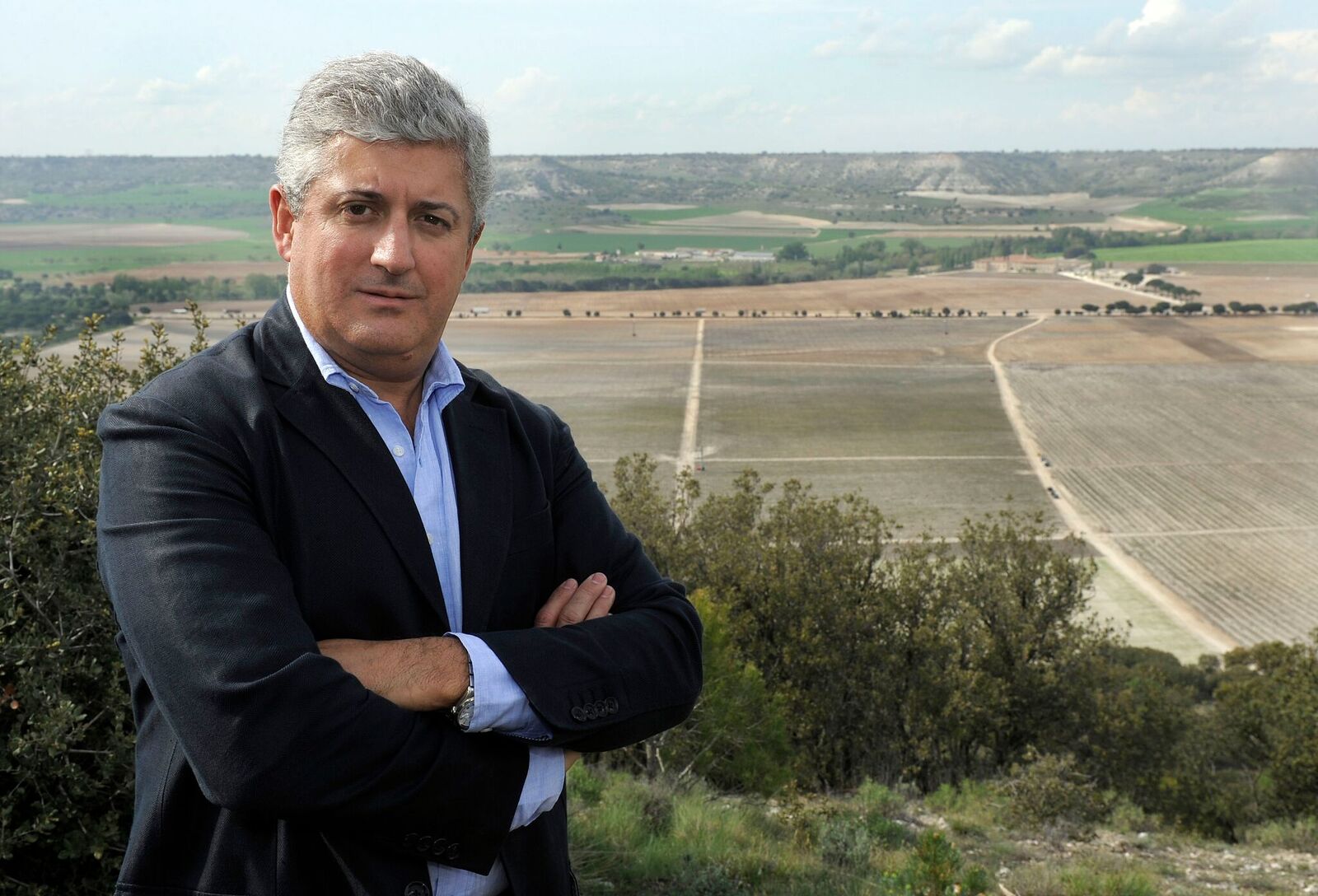
“Every effort
to reduce our carbon footprint is being made,”
says Valero. They are also growing grapes on
pre-phylloxera vines, intended to go into their
future flagship wine. The winery uses only gravity
presses to crush the grapes, which arrive at the
winery in small 26-pound batches just a half hour
after leaving the vineyards. And
they spend $1.70 per cork to decrease the
possibility of tainted wines. “You’ll be able to
enjoy our wines in ten or twenty years,” he
insists.
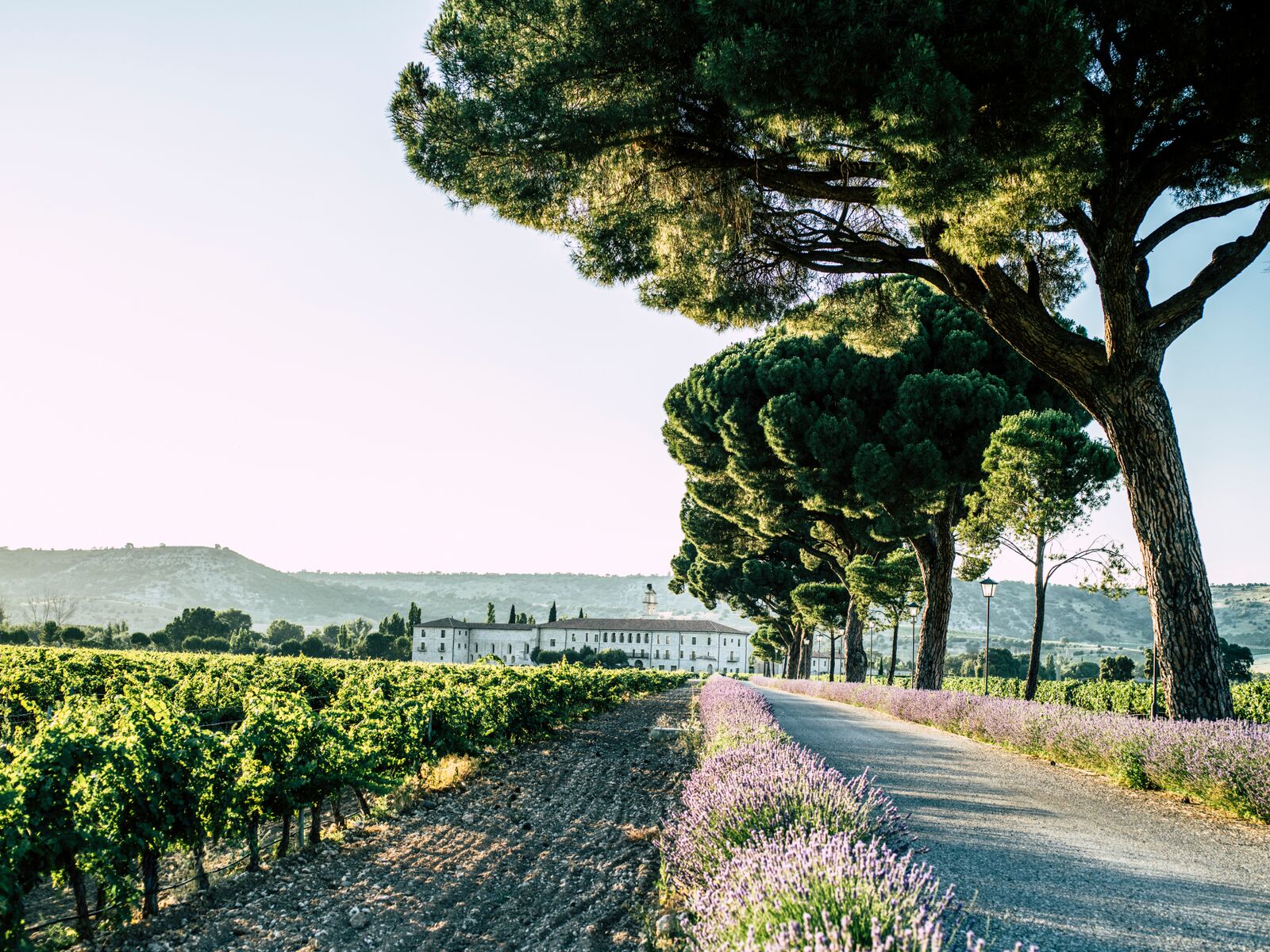 The
real advantages of not having to go by EU rules for
appellations are that Abadia can use drip
irrigation, if needed, and they can experiment
with growing any varietals they choose.
The
real advantages of not having to go by EU rules for
appellations are that Abadia can use drip
irrigation, if needed, and they can experiment
with growing any varietals they choose.
What I found remarkable on
tasting Abadia’s wines was the modest price
charged for many of them—about $26-$30 for their
current Selección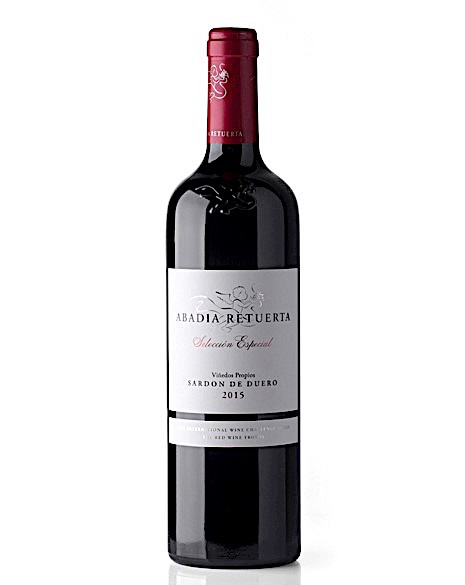 Especial
2014 vintage, a Bordeaux-like blend of fruit
flavors and soft tannins, made from 75%
Tempranillo, with Cabernet Sauvignon, Syrah and
Merlot usually added. (I’ve also found that wine
even cheaper in U.S. wine stores.)
Especial
2014 vintage, a Bordeaux-like blend of fruit
flavors and soft tannins, made from 75%
Tempranillo, with Cabernet Sauvignon, Syrah and
Merlot usually added. (I’ve also found that wine
even cheaper in U.S. wine stores.)
The estate’s small production,
single vineyard reds (tintos de
pago) cost more, around $68,
like the Pago Negralada and Pago Valdebellón.
Pago Garduña 2006, which I had over dinner, is a
superbly rich blend of Syrah and Petit Verdot, a
rarity of only about a thousand bottles that can
cost $113. I was also intrigued over lunch by Le
Domaine, a unique blend of 60% Sauvignon Blanc
and 40% Verdejo.
Given
such freedom to produce what its wants, Abadia
has, at least for the moment, stopped trying to
convince the Instituto Nacional
de Denominaciones de Origin to give it Ribera del
Douro status.
“We’ve been so successful that
they can’t ignore us,” said Valero. “So who knows?
They may well give us our own appellation based on
our location of Sardón de Duero. We
certainly have no plans to change.”
❖❖❖
 FOOD WRITING 101: TRY NOT
TO LET ON THAT YOU REALLY HATE
FOOD
FOOD WRITING 101: TRY NOT
TO LET ON THAT YOU REALLY HATE
FOOD
"And
what’s so good about those robust food cultures
anyway? They tend to be inward-looking and
small-minded. Two weeks in Tuscany sounds like a
fabulous idea. Then the reality slides in, like ink
seeping slowly across blotting paper: day after day of
the same bloody pasta dishes, the same rustic salads
and anything for dessert as long as it’s tira-sodding-misu or
something `inventive' involving pears and almonds. . .
. We eat more widely and thrillingly in Britain
specifically because of the weakness of our indigenous
food culture.”—Jay Raynor, "The
cliché is French food is better than ours. The trouble
is, it's true," The Guardian (9/13/18)
LAS VEGAS CHAPTER, NUMBER 35,446
The world’s
largest gin
and tonic was mixed in Las Vegas on Nov. 5 in a
300-gallon glass, required more than 400 bottles of
gin, 165 gallons of tonic water and approximately 5.5
gallons of lime juice.
Wine
Column Sponsored by Banfi Vintners
SANGIOVESE
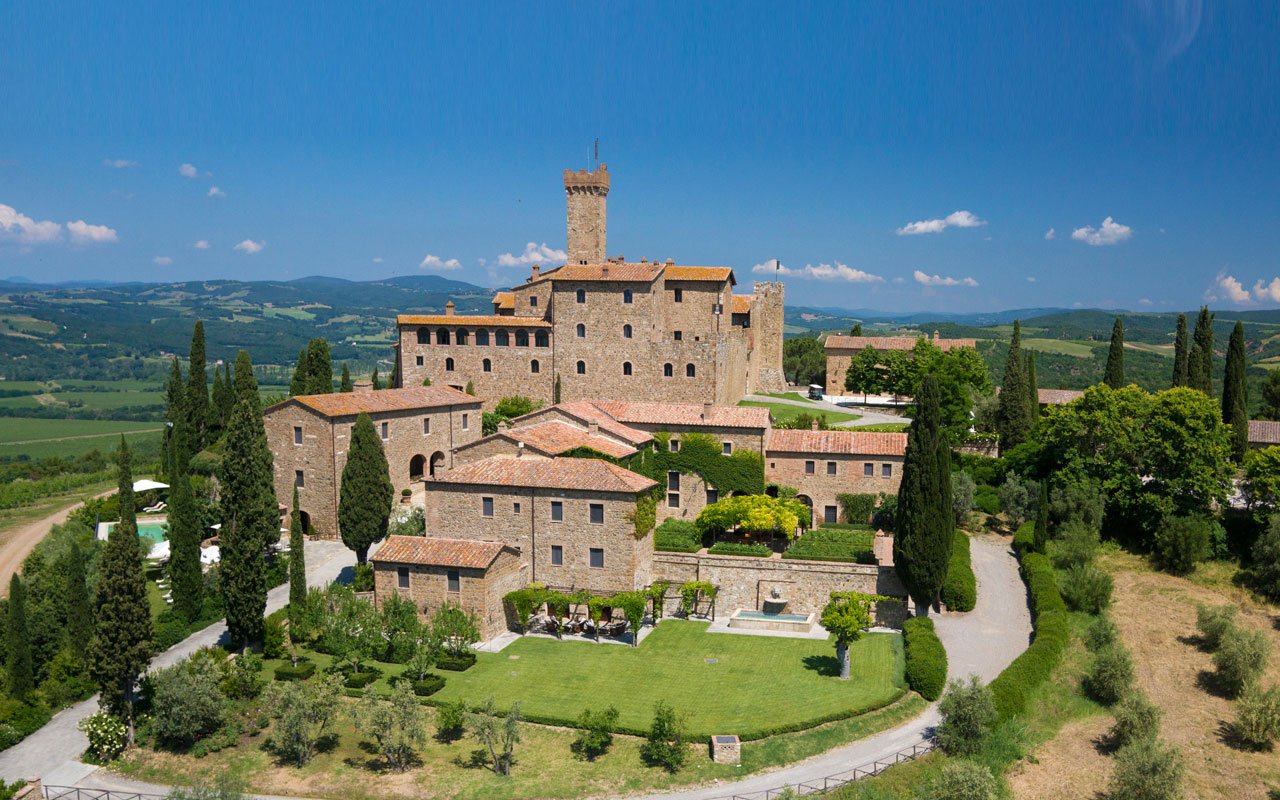 Wine is a joy year-round but
in cooler weather one
grape varietal has really taken center stage in
my daily activities – that most Italian of
grapes, Sangiovese, and its ultimate expression
– Brunello di Montalcino.
Wine is a joy year-round but
in cooler weather one
grape varietal has really taken center stage in
my daily activities – that most Italian of
grapes, Sangiovese, and its ultimate expression
– Brunello di Montalcino.
From mid-September through mid-October,
the Sangiovese grown for our various styles of red
wines are be harvested, culminating with the top
selection for Brunello di Montalcino.
Second, cooler weather here means
it is time to start enjoying more red wines and
especially Sangiovese based wines. That
includes Banfi’s cru of Brunello, Poggio alle Mura,
literally the cream of the crop of our Sangiovese
vineyards. Alongside our Poggio alle Mura Brunello di
Montalcino, this year we introduced two more wines
from the cru Poggio alle Mura – a Rosso di Montalcino
and a Riserva of Brunello. Rosso is sort of like the
younger brother of Brunello, also made from 100%
Sangiovese grapes but usually a selection from younger
vines and the wine is aged only two years compared to
the four required for Brunello. The
Riserva, on the other hand, is an even more selective
harvest of Sangiovese, and ages for an additional year
before release.
What is so special about this cru
Poggio alle Mura?
Well, it is the result our over 30 years of
ongoing research at my family’s vineyard estate,
Castello Banfi.
When we first began planting our vines there in
the late 1970s studies from the University of Bordeaux
indicated which strains of many varietals we should
plant, based on the soil type and microclimate of each
vineyard. But
when it came to the region’s native Sangiovese, there
was only local lore, no scientific research. So we took
it upon ourselves to figure out this vine, and set off
on three decades of incredibly detailed research.
We started
with 600 apparent variations on Sangiovese, because it
is so susceptible to variations in weather and soil,
and narrowed that down to 160 truly genetically
different clones.
We planted a vineyard with two rows of each
type, made wine from each of them, and charted the
differences – remember, you only get one chance a year
to make wine, so this took time.
It took about ten years to get some
concrete results, though we continue to experiment
today and always will – you never stop learning in
science and nature!
Once we determined which were the best,
complementary clones that could be planted together to
make the best Brunello, we chose to plant them in what
we determined to be the optimal vineyard sites. Coincidentally,
the best soils and climate conditions are in the
slopes surrounding the medieval fortress today known
as Castello Banfi, known since Etruscan times as
Poggio alle Mura – the walled hilltop. Hence the
name of our most special “cru” of Brunello,
representing a synthesis between tradition and
innovation.
Though the focus of this study was
our Brunello, all of our Sangiovese-based wines,
including the super Tuscans SummuS, Cum Laude, and
Centine, benefitted from this work. And that’s
the third reason for celebrating Sangiovese this
month, for the range of wonderful reds that usher us
into autumn! One
wine in particular was inspired by our research – the
BelnerO, a Sangiovese dominant blend with what I like
to call a kiss of Cabernet and a whisper of Merlot. We grow the
grapes a little differently for BelnerO than for
Brunello, make the wine with less oak aging and
released it earlier from the winery, providing a
counterpoint to Brunello and a lovely terroir-driven
wine in its own right.
If you
know Italians, you know that by nature we are
multi-faceted, varying in mood, and always passionate. As a
nation, we span from the hot sunny beaches of Sicily
near the African coast to the rugged mountains and
Alpine ski slopes of Trentino-Alto Adige in the north. Sangiovese
is grown in almost all of Italy’s regions and reflects
the unique nature of each; it is most famous
(rightfully so) in Tuscany, yet even there it reflects
the nuances of each hilltop, valley and subzone. It has
something a little different to say in Brunello than
Chianti, Morellino than Vino Nobile di Montepulciano,
Rosso di Montalcino than Super Tuscan blends.
Here is a smattering of
Sangiovese-based wines that you may wish to get to
know better, reflecting a spectrum that appeals to
every occasion, every taste, and every budget. We can
assure you that the conversation will never become
boring. 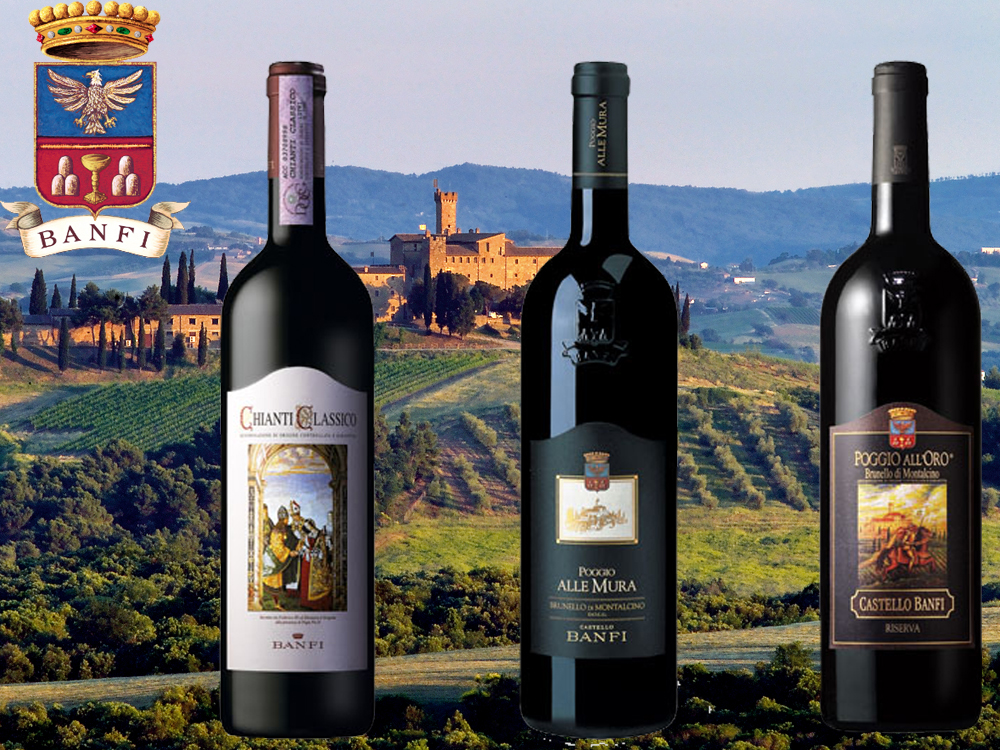
Recommendations for Celebrating
Sangiovese
BelnerO Proprietor’s Reserve Sangiovese
– A refined
cuvée of noble red grapes perfected by our pioneering
clonal research. This dark beauty, BelnerO, is
produced at our innovative winery, chosen 11
consecutive years as Italy’s Premier Vineyard Estate.
Fermented in our patented temperature controlled
French oak and aged approximately 2 additional years.
Unfiltered, and Nitrogen bottled to minimize sulfites.
Castello Banfi Brunello di Montalcino –
Rich, round, velvety and intensely
aromatic, with flavor hints of licorice, cherry, and
spices. Brunello di Montalcino possesses an intense
ruby-red color, and a depth, complexity and opulence
that is softened by an elegant, lingering aftertaste.
Unfiltered after 1998 vintage.
Castello Banfi Rosso di Montalcino – Brunello's "younger brother," produced
from select Sangiovese grapes and aged in barrique for
10 to 12 months. Deep ruby-red, elegant, vibrant,
well-balanced and stylish with a dry velvety
finish.
Poggio all’Oro Brunello di Montalcino
Riserva – A single vineyard selection of our most
historically outstanding Sangiovese, aged five years
before release, the additional year more than that
required of Brunello including 6 months in barrel and
6 months more in bottle to grant its “Riserva”
designation. Incredible
elegance and harmony. Intense with lots of fruit and
subtle wood influence. Round, complete, well balanced
with hints of chocolate and berries. Unfiltered after
1998.
Poggio alle Mura – The first tangible result of years of
intensive clonal research on Montalcino’s native
Sangiovese grape.
Estate bottled from the splendidly sun drenched
vineyards surrounding the medieval Castello from which
it takes its name.
The Brunello
di Montalcino is seductive, silky and smoky. Deep ruby
in color with an expressive bouquet of violets, fruits
and berries as well as cigar box, cedar and exotic
spices. The Rosso
di Montalcino is also intense ruby red. The bouquet
is fresh and fruity with typical varietal notes of
cherry and blackberry, enriched by more complex hints
of licorice, tobacco and hazelnut. It is full
bodied, yet with a soft structure, and a surprisingly
long finish. The Poggio alle Mura Brunello di Montalcino
Riserva is deep ruby red with garnet
reflections and a rich, ample bouquet that hints of
prune jam, coffee, cacao and a light balsamic note. It is full
and powerful, with ripe and gentle tannins that make
it velvety and harmonious; this wine is supported by a
pleasing minerality that to me speaks soundly of that
special hillside in southern Montalcino.
SummuS – A wine of towering elegance, SummuS is an
extraordinary blend of Sangiovese which contributes
body; Cabernet Sauvignon for fruit and structure; and
Syrah for elegance, character and a fruity bouquet. An elegant,
complex and harmonious red wine.
Cum Laude – A complex and elegant red which graduated
“With Honors,” characterized by aromas of juicy
berries and fresh spices.
Centine – A Cuvee that is more than half
Sangiovese, the balanced consisting of equal parts of
Cabernet Sauvignon and Merlot. Vinified in
a firm, round style that easily accompanies a wide
range of dishes, this is a smooth and fragrantly
satisfying wine with international character, and a
perennial favorite at my own dinner table.
Banfi Chianti Superiore – The “Superiore” designation signifies
stricter government regulations regarding production
and aging requirements, as compared to regular
Chianti. An
intense ruby red wine with fruit forward aromas and
floral notes. This
is a round wine with well-balanced acidity and fruit.
Banfi Chianti Classico – An enduring classic: alluring
bouquet of black fruit and violets; rich flavors of
cherry and leather; supple tannins and good acidity
for dining.
Banfi Chianti Classico Riserva – Produced from select grapes grown in the
"Classico" region of Chianti, this dry, fruity and
well-balanced red has a full bouquet reminiscent of
violets.
Fonte alla Selva Chianti Classico – This is our newest entry into the Chianti
arena, coming from a 99 acre estate in Castellina, the
heart of the Chianti Classico region. The wine is
a captivating mauve red that smells of cherry, plum
and blackberry with hints of spice. It is
round, full and balanced with very good
acidity.
Col di Sasso – Sangiovese and Cabernet Sauvignon. Luscious,
complex and soft with persistent notes of fruit and
great Italian style structure.
Any of John Mariani's books below may be ordered from amazon.com.
 The Hound in Heaven
(21st Century Lion Books) is a novella, and
for anyone who loves dogs, Christmas, romance,
inspiration, even the supernatural, I hope you'll find
this to be a treasured favorite. The story
concerns how, after a New England teacher, his wife and
their two daughters adopt a stray puppy found in their
barn in northern Maine, their lives seem full of promise.
But when tragedy strikes, their wonderful dog Lazarus and
the spirit of Christmas are the only things that may bring
his master back from the edge of despair.
The Hound in Heaven
(21st Century Lion Books) is a novella, and
for anyone who loves dogs, Christmas, romance,
inspiration, even the supernatural, I hope you'll find
this to be a treasured favorite. The story
concerns how, after a New England teacher, his wife and
their two daughters adopt a stray puppy found in their
barn in northern Maine, their lives seem full of promise.
But when tragedy strikes, their wonderful dog Lazarus and
the spirit of Christmas are the only things that may bring
his master back from the edge of despair. WATCH THE VIDEO!
“What a huge surprise turn this story took! I was completely stunned! I truly enjoyed this book and its message.” – Actress Ali MacGraw
“He had me at Page One. The amount of heart, human insight, soul searching, and deft literary strength that John Mariani pours into this airtight novella is vertigo-inducing. Perhaps ‘wow’ would be the best comment.” – James Dalessandro, author of Bohemian Heart and 1906.
“John Mariani’s Hound in Heaven starts with a well-painted portrayal of an American family, along with the requisite dog. A surprise event flips the action of the novel and captures us for a voyage leading to a hopeful and heart-warming message. A page turning, one sitting read, it’s the perfect antidote for the winter and promotion of holiday celebration.” – Ann Pearlman, author of The Christmas Cookie Club and A Gift for my Sister.
“John Mariani’s concise, achingly beautiful novella pulls a literary rabbit out of a hat – a mash-up of the cosmic and the intimate, the tragic and the heart-warming – a Christmas tale for all ages, and all faiths. Read it to your children, read it to yourself… but read it. Early and often. Highly recommended.” – Jay Bonansinga, New York Times bestselling author of Pinkerton’s War, The Sinking of The Eastland, and The Walking Dead: The Road To Woodbury.
“Amazing things happen when you open your heart to an animal. The Hound in Heaven delivers a powerful story of healing that is forged in the spiritual relationship between a man and his best friend. The book brings a message of hope that can enrich our images of family, love, and loss.” – Dr. Barbara Royal, author of The Royal Treatment.
 |
The Encyclopedia of American Food and Drink by John F. Mariani (Bloomsbury USA, $35) Modesty forbids me to praise my own new book, but let me proudly say that it is an extensive revision of the 4th edition that appeared more than a decade ago, before locavores, molecular cuisine, modernist cuisine, the Food Network and so much more, now included. Word origins have been completely updated, as have per capita consumption and production stats. Most important, for the first time since publication in the 1980s, the book includes more than 100 biographies of Americans who have changed the way we cook, eat and drink -- from Fannie Farmer and Julia Child to Robert Mondavi and Thomas Keller. "This book is amazing! It has entries for everything from `abalone' to `zwieback,' plus more than 500 recipes for classic American dishes and drinks."--Devra First, The Boston Globe. "Much needed in any kitchen library."--Bon Appetit. |
"Eating Italian will never be the same after reading John Mariani's entertaining and savory gastronomical history of the cuisine of Italy and how it won over appetites worldwide. . . . This book is such a tasteful narrative that it will literally make you hungry for Italian food and arouse your appetite for gastronomical history."--Don Oldenburg, USA Today. "Italian
restaurants--some good, some glitzy--far
outnumber their French rivals. Many of
these establishments are zestfully described
in How Italian Food Conquered the World, an
entertaining and fact-filled chronicle by
food-and-wine correspondent John F.
Mariani."--Aram Bakshian Jr., Wall Street
Journal.
"Equal parts
history, sociology, gastronomy, and just
plain fun, How Italian Food Conquered the
World tells the captivating and delicious
story of the (let's face it) everybody's
favorite cuisine with clarity, verve and
more than one surprise."--Colman Andrews,
editorial director of The Daily
Meal.com. "A fantastic and fascinating
read, covering everything from the influence
of Venice's spice trade to the impact of
Italian immigrants in America and the
evolution of alta cucina. This book will
serve as a terrific resource to anyone
interested in the real story of Italian
food."--Mary Ann Esposito, host of PBS-TV's
Ciao
Italia. "John Mariani has written the
definitive history of how Italians won their
way into our hearts, minds, and
stomachs. It's a story of pleasure over
pomp and taste over technique."--Danny Meyer,
owner of NYC restaurants Union Square
Cafe, The Modern, and Maialino.
|
 |
 |
 |
 |
 |
 |
 |
 |
 Everett Potter's Travel Report:
Everett Potter's Travel Report: 
 Eating Las Vegas
JOHN CURTAS has been covering the Las Vegas
food and restaurant scene since 1995. He is
the co-author of EATING LAS VEGAS – The 50
Essential Restaurants (as well as
the author of the Eating Las Vegas web site: www.eatinglasvegas.
He can also be seen every Friday morning as
the “resident foodie” for Wake Up With the
Wagners on KSNV TV (NBC) Channel 3 in
Las Vegas.
Eating Las Vegas
JOHN CURTAS has been covering the Las Vegas
food and restaurant scene since 1995. He is
the co-author of EATING LAS VEGAS – The 50
Essential Restaurants (as well as
the author of the Eating Las Vegas web site: www.eatinglasvegas.
He can also be seen every Friday morning as
the “resident foodie” for Wake Up With the
Wagners on KSNV TV (NBC) Channel 3 in
Las Vegas.
MARIANI'S VIRTUAL GOURMET
NEWSLETTER is published weekly. Publisher: John Mariani. Editor: Walter Bagley. Contributing Writers: Christopher Mariani,
Robert Mariani, Misha Mariani, John A. Curtas, Gerry Dawes, Geoff Kalish,
and Brian Freedman. Contributing
Photographer: Galina Dargery. Technical
Advisor: Gerry
McLoughlin.
If you wish to subscribe to this
newsletter, please click here: http://www.johnmariani.com/subscribe/index.html
© copyright John Mariani 2017

